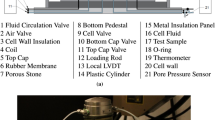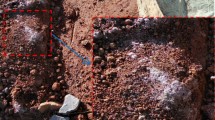Abstract
The artificial ground freezing (AGF) method has been used in many geotechnical engineering applications such as temporary excavation support, underpinning and groundwater cutoff. The AGF method utilizes a refrigerant such as liquid nitrogen or brine, circulating through embedded freezing pipes in order to freeze the ground. In this paper, two in-situ cryogenic freezing experiments (i.e., single freezing-pipe test and frozen-wall formation test) were performed using liquid nitrogen to simulate the AGF in a Korean marine clay deposit, in which the freezing rate was evaluated. The thermal conductivity of frozen and unfrozen marine clay was evaluated by performing typical laboratory experiments. In addition, the strength and stiffness of frozen-thawed deposits were comparatively measured by sounding tests (i.e., piezocone penetration test and lateral loading test). The freezing rate of the frozen-wall formation test in the Korean marine clay deposit was approximately twice as high as that of the single freezing pipe test. Compared to the original marine clay deposit, the frozen-thawed marine clay showed a significant reduction in strength and stiffness.
Similar content being viewed by others
References
Angin I, Sari S, Aksakai EL (2016) Effects of diatomite (DE) application on physical properties of soils subjected to freeze-thaw cycles. Soil and Tillage Research 160(1):34–41, DOI: https://doi.org/10.1016/j.still.2016.02.008
Arenson LU, Sego DC (2006) The effect of salinity on the freezing of coarse-grained sands. Canadian Geotechnical Journal 43(3):325–337, DOI: https://doi.org/10.1139/t06-006
Chamberlain EJ, Blouin SE (1977) Freeze-thaw enhancement of the drainage and consolidation of fine-grained dredged material in confined disposal areas. Technical Report D-77–16, U.S. Army Cold Regions Research and Engineering Laboratory, Foundations and Materials Research Branch, Hanover, NH, USA
Cheng YC, Ge Q, He Y (2012) Experimental research on the shear strength deterioration between the freezing and thawing surface of melting soil slope in seasonal frozen regions. Proceedings of 9th international conference of Chinese transportation professionals, August 5–9, Harbin, China
Crippa C, Manassero V (2012) Artificial ground freezing at sophiaspoor tunnel (The Netherlands) — Freezing parameters: Data acquisition and processing. Proceedings of Geo Congress 2006, February 26–March 1, Atlanta, GA, USA
Eigenbrod KD (1996) Effects of cyclic freezing and thawing on volume changes and permeabilities of soft fine-grained soils. Canadian Geotechnical Journal 33(4):529–537, DOI: https://doi.org/10.1139/cgj-33-4-529
Geng P, Yan Q, He C, Wang B (2010) Numerical simulation of underground construction by horizontal ground freezing method. Engineering Mechanics 27(5):122–127
Han L, Ye GL, Li YH, Xia XH, Wang JH (2016) In situ monitoring of frost heave pressure during cross passage construction using ground-freezing method. Canadian Geotechnical Journal 53(3):530–539, DOI: https://doi.org/10.1139/cgj-2014-0486
Kersten MS (1949) Laboratory research for the determination of the thermal properties of soils. ACFEL Technical Report 23, AD71256, Research Laboratory Engineering, University of Minnesota, Minneapolis, MN, USA
Konard JM (2002) Prediction of freezing-induced movements for an underground construction project in Japan. Canadian Geotechnical Journal 39(6):1231–1242, DOI: 10.1139/t02-077
Kudryatsev SA (2004) Numerical modeling of the freezing, frost heaving, and thawing of soil. Soil Mechanics and Foundation Engineering 41(5):177–184, DOI: https://doi.org/10.1007/s11204-005-0005-z
Lackner R Pichier C, Kloiber A (2008) Artificial ground freezing of fully saturated soil: Viscoelastic behavior. Journal of Engineering Mechanics 134(1):1–11, DOI: https://doi.org/10.1061/(ASCE)0733-9399(2008)134:1(1)
Li D, Wang H (2012) Investigation into artificial ground freezing technique for a cross passage in metro. Proceedings of GeoShanghai international conference 2010, June 3–5, Shanghai, China
Liu Z, Liu J, Li X, Fang J (2019) Experimental study on the volume and strength change of an unsaturated silty clay upon freezing. Cold Regions Science and Technology 157:1–12, DOI: https://doi.org/10.1016/j.coldregions.2018.09.008
Lunne T, Chritoffesen HP, Tjelta TI (1985) Engineering use of piezocone data in North Sea clays. Proceedings of 11th international conference on soil mechanics and foundation engineering, August 12–16, San Francisco, CA, USA
Manassero V, Salvo GD, Giannelli F, Colombo G (2008) A combination of artificial ground freezing and grouting for the excavation of a large size tunnel below groundwater. Proceedings of 6th international conferences on case histories in geotechnical engineering, August 11–16, Arlington, VA, USA
Marwan A, Zhou MM, Abdelrehim MZ (2016) Optimization of artificial ground freezing in tunneling in the presence of seepage flow. Computers and Geotechnics 75(1):112–125, DOI: https://doi.org/10.1016/j.compgeo.2016.01.004
Padilla F, Villeneuve JP, Stein J (1997) Simulation and analysis of frost heaving in subsoils and granular fills of roads. Cold Regions Science and Technology 25(2):89–99, DOI: https://doi.org/10.1016/S0165-232X(96)00018-3
Pimentel E, Papakonstantinou S, Anagnostou G (2012) Numerical interpretation of temperature distributions from three ground freezing applications in urban tunneling. Tunnelling and Underground Space Technology 28(1):57–69, DOI: https://doi.org/10.1016/j.tust.2011.09.005
Qi J, Vermeer PA, Cheng G (2006) A review of the influence of freeze-thaw cycles on soil geotechnical properties. Permafrost and Periglacial Processes 17(3):245–252, DOI: https://doi.org/10.1002/ppp.559
Russo G, Corbo A, Cavuoto F, Autuori S (2015) Artificial ground freezing to excavate a tunnel in sandy soil: Measurements and back analysis. Tunnelling and Underground Space Technology 50(1):226–238, DOI: https://doi.org/10.1016/j.tust.2015.07.008
Shawn PC, Juan LP, Michael AS (2016) Ground freezing to repair leaks in a slurry wall shaft. Proceedings of world tunnel congress 2016, April 22–28, San Francisco, CA, USA
Shin EC, Ryu BH, Park JJ (2013) The frost heaving susceptibility evaluation of subgrade soils using laboratory freezing system. Journal of Korean Geosynthetics Society 12(2):13–23
Song H, Cai H, Yao Z, Rong C, Wang X (2016) Finite element analysis on 3D freezing temperature field in metro cross passage construction. Procedia Engineering 165(1):528–539, DOI: https://doi.org/10.1016/j.proeng.2016.11.729
Sun C, Qiu P (2012) Research on the freezing method applied to tunnel cross passage of the Guangzhou metro. Modern Tunneling Technology 49(3):161–165
Suyama K, Imai T, Ohya S (1986) Development of LLT pressuremeter and its application in prediction of pile behavior under horizontal load. Proceedings of symposium on the pressuremeter and its marine applications, May 2–3, College Station, TX, USA
Tang L, Cong S, Geng L, Ling X, Gan F (2018) The effect of feeze-thaw cycling on the mechanical properties of expansive soils. Cold Regions Science and Technology 145:197–207, DOI: https://doi.org/10.1016/j.coldregions.2017.10.004
Vitel M, Rouabhi A, Tijani M, Guérin F (2015) Modeling heat transfer between a freeze pipe and the surrounding ground during artificial ground freezing activities. Computers and Geotechnics 63:99–111, DOI: https://doi.org/10.1016/j.compgeo.2014.08.004
Wang DY, Ma W, Niu YH, Chang XX, Wen Z (2007) Effects of cyclic freezing and thawing on mechanical properties of Qinghai-Tibet clay. Cold Regions Science and Technology 48:34–43, DOI: https://doi.org/10.1016/j.coldregions.2006.09.008
Wei Q, Ping Y, Ming J, Ting Z (2010) Application and survey analysis of freezing method applied to ultra-long connected aisle in metro tunnel. Chinese Journal of Underground Space and Engineering 6(5):1065–1071
Yan Q, Fang X (2012) Thermal-solid coupling analysis of the connected of the cross aisle in metro constructed by horizontal freezing in ground. China Railway Science 33(1):54–59
Yang P, Ke JM, Wang JG, Chow YK, Zhu FB (2006) Numerical simulation of frost heave with coupled water freezing, temperature and stress fields in tunnel excavation. Computers and Geotechnics 33(6):330–340, DOI: https://doi.org/10.1016/j.compgeo.2006.07.006
Acknowledgments
This work was supported by the National Research Foundation of Korea (NRF) grant funded by the Korea government (MSIT) (No. 2019R1A2C2086647).
Author information
Authors and Affiliations
Corresponding author
Rights and permissions
About this article
Cite this article
Choi, HJ., Lee, D., Won, J. et al. Influence of In-situ Cryogenic Freezing on Thermal and Mechanical Characteristics of Korean Marine Clay. KSCE J Civ Eng 24, 3501–3515 (2020). https://doi.org/10.1007/s12205-020-0457-8
Received:
Revised:
Accepted:
Published:
Issue Date:
DOI: https://doi.org/10.1007/s12205-020-0457-8




